|
|
|
|
|
|
|
|
|
|
|
|
|
|
|
|
|
|
|
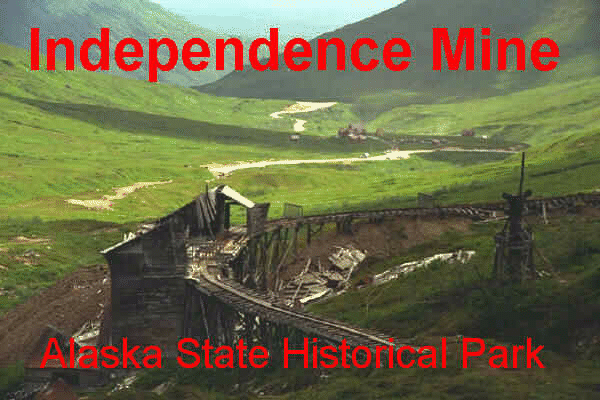
|
|
|
|
|
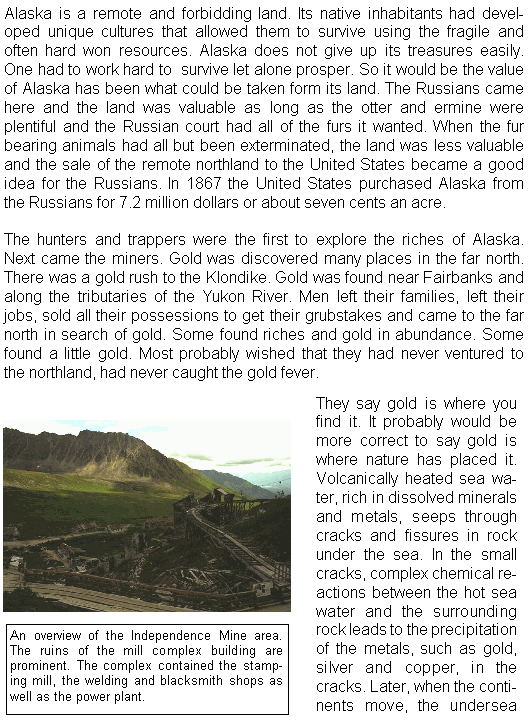
|
|
|
|
|
|
|
|
|
|
rock is raised above the sea and becomes land. The precipitated gold in the cracks and crevices in the rock are veins of gold. In the large cracks and crevices there is the mother lode.
|
|
|
|
|
|
|
|
|
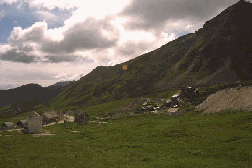
|
|
|
|
|
|
|
|
|
|
The mine entrance and mining facility shops are located on the uphill side of Fishhook Creek and the living and office facilities re on the downhill side. Some of the dormitory buildings have been partially restored. The light colored area on the left is the "tailings" pile and is the worthless rock removed to make the access tunnels and removed through the water tunnel.
|
|
|
|
|
|
|
|
|
|
|
|
|
|
|
|
|
|
The original mine opening is almost 1,000 feet above the building complex. Until the completion of the water tunnel in the 1940's, access to the mine was by a long stairway from the building complex and up the side of Granite Mountain. Remains of the snow shed that protected the miners from the snow and wind can be seen on the mountain side. The harsh elements have reduced the snow shed to a pile of rubble. The shed at the top of the stairway protected the mine entrance and is where ore was loaded into the tram carts before the opening of the water tunnel.
|
|
|
|
|
|
|
|
|
|
|
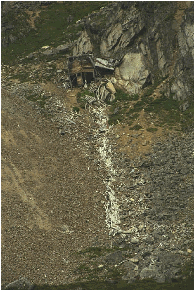
|
|
|
|
|
|
|
|
|
|
Natural forces, the wind, the rain, freezing and thawing, slowly break down the rock. The broken pieces of granite and the its entrapped gold find their way into the
|
|
|
|
|
|
|
|
|
|
|
|
|
|
|
|
|
streams and rivers. It is this placer gold that is usually found first. Miners pan the sand and gravel of the streams and rivers seeking color; gold in their pans. When they find color, they take what they can form the gravel because the ore has already been mined and sits beneath their feet. Even so, the miners look upstream. They look to where the gravel has come from and dream of finding the source of the placer gold. The miners know that upstream, in the mountains, near the headwaters of the river, there is the mother lode.
|
|
|
|
|
|
|
|
|
|

|
|
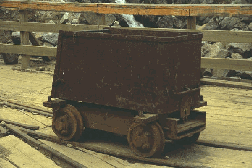
|
|
|
|
|
|
|
|
|
|
|
|
Storage shed in a series of buildings hosing the sheet metal, plumbing and electrical shops. Snow load during the long winters has broken the spine of the building and it leans precariously. The mine buildings received virtually no maintenance for 20 years before becoming a state historical park.
|
|
|
|
|
|
|
|
|
|
|
|
|
|
|
What mine would be complete without an ore cart? When the only mine opening was 1,000 feet above the mill, the ore was lowered from the mountain side by a system of hoppers and cables. With the completion of the water tunnel, ore carts were able to transport the ore out of the mine and deliver it to the mill complex.
|
|
|
|
|
|
|
|
|
|
|
|
|
|
|
|
|
Even before the discovery of gold in the Yukon and the Klondike, gold was discovered southeast of Anchorage in 1886. The small community of Hope, Alaska took its name fro the men who traveled there hoping to find their share of the yellow metal. After the discovery of gold along the Cook Inlet, the miners fanned out and searched the wilds of the Mantanuska and Susitna Valleys and the rugged granite Talkeetna Mountains.
Venturing high into the Willow Creek Valley, Robert Lee Hatcher found what he had been searching for. At an altitude of 3,500 feet above sea level, Hatcher found gold in the Talkeetna Mountains in September 1906. Many others soon followed and many mines were dug into the granite mountains. Hardrock miners were searching for the mother lode. Hardrock mining is expensive and labor intensive. It isn't something for the individual or even the small company. Many companies pooled their resources to search out the veins of gold hidden inside the mountain. In 1938 the Independence Mine and the Alaska Free Gold Mine companies merged and the Alaska Consolidated Mining Company was formed. The Alaska Consolidated Mining Company was the largest mining concern in the Willow Creek Mining District with more than eighty mining claims.
|
|
|
|
|
|
|
|
|

|
|

|
|
|
|
|
|
|
|
|
|
|
(left) Partially restored bunkhouse. Erected in 1940, the building could accommodate 50 men. The bottom floor also had the dual-purpose school room - movie room.
(right) Stabilized timber and framing shop. Painted plywood is used to simulate windows in many of the buildings in the park. The corrugated sheet metal roofing is corroded and the unpainted timber exterior is severely weather checked. The timber frames used to stabilize the underground shafts were constructed here and then carried to the mine.
|
|
|
|
|
|
|
|
|
|
|
|
|
|
|
|
The Alaska Consolidate Mine continued to grow. In 1941, its highest production year, the mine consisted of twenty-seven buildings, had over 200 employees, constructed over ten miles of tunnels in side the mountain and produced over 34,000 ounces of gold valued at over one million dollars. That much gold at today's prices would be worth more than seventeen million dollars.
The World War came to America in 1942. Gold mining was not essential to the war economy and gold production at the mine was halted. The mine continued to mine low-grade tungsten ore but this operation was halted in 1943 and the mine ordered closed. The mine remained closed for the duration of the war.
After the war, mining resumed in 1946. Gold could only be sold to the US Government and the price was fixed at $35 per ounce. In a period of inflation following the war, the mining operation at Alaska Consolidated Mining became unprofitable. In January 1951, the mine was finally closed. In its lifetime the mine produced almost six million dollars (in values of the day) worth of gold. The Alaska Consolidated Mine was the largest and most active mine in the area. With its closing, the character of the area changed forever and the history of mining in Alaska turned a new page.
|
|
|
|
|
|
|
|
|
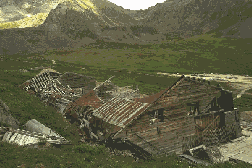
|
|
|
|
|
|
In 1974, Independence Mine was placed on the Register of Historic Places. Later, the owners of the mine donated 270 acres to the State of Alaska's Division of Parks ad Outdoor Recreation and the Independence Mine State Historical Park was formed in 1980.
The mine manager's home has been restored and now serves as office and visitor center for the park. There are many interpretive displays in the visitor center. Many of the guides and
|
|
|
|
|
|
|
|
|
|
|
|
|
|
|
|
Mine shops located next to the water tunnel. When originally built, the building was stabilized with steel cable that anchored the building to the mountain side. The one end wall is the only part of the building still standing.
|
|
|
|
|
|
|
|
|
|
|
|
|
|
|
|
|
workers in the park are members of The Friends of Independence Mine, a non-profit corporation. The Friends of Independence Mine are volunteers dedicated to the preservation of Independence Mine. They work on the restoration projects and hold fund raising activities to aid in the preservation of the park site.
Many of the buildings in the park have been partially restored or stabilized. The assay office and the mine manager's home are the only buildings to which the public has inside access. Many of the other buildings and facilities are in poor and deteriorating condition. The State of Alaska has cut funding for the maintenance and improvements to the park. Recently the state has entered into discussions with interested parties with the intent of turning over the operation of the park to private sources. The future of the park and an important chapter in the history of Alaska in jeopardy.
After the long drive up the mountain, one can reflect on the difficulties and hardships experienced by the men and women who lived and worked Independence Mine. Today the drive can still a long and hard one even with modern four-wheel drive vehicles. In the period before the Second World War, Anchorage was a very small town. Palmer and Wasilla were the tiniest of farming communities. The road to Independence Mine was a long dirt road far removed fro any town or outside assistance. It must have been a lonely existence. The crew of the mine had to rely on one another for just about everything. It was a hardy breed who lived and worked at the mine.
The mine has a long history. It was in near constant operation for almost half a century. After the closure of the mine and before it was turned over t the state to become a park, there was a period of almost twenty years without maintenance or improvements. The winters high in the Talkeetna Mountains have taken their toll on the mine facilities. Many of the buildings have collapsed under the weight of the snow and the force of the winds. Many have been stabilized through the hard work and effort of unpaid volunteers but the dwindling budget has made further improvements doubtful. A visit to Independence Mine State Historical Park is a journey back in time to another era in the history of Alaska.
------------------------------------
|
|
|
|
|
|
|
|








